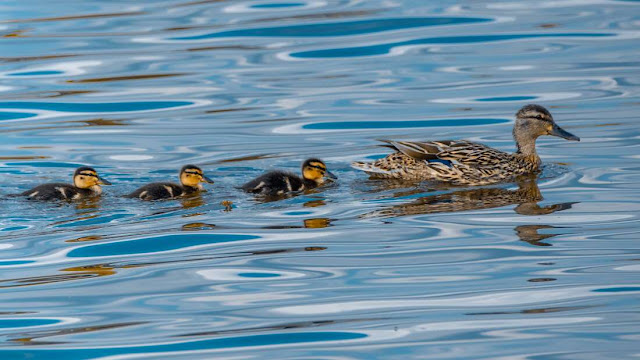The idiom “getting your ducks in a row” wasn’t actually inspired by the birds of the same name in the family Anatidae, but when it comes to their offspring there is something to be said for orderly queues boosting productivity. A new study decided to pin down the reason why ducklings swim in a row behind mom, and – blessed be thy mallard – the results were even more adorable than one could’ve hoped for.
Published in the Journal of Fluid Mechanics, the study sought to answer three questions; why do they swim like this, what is the best formation, and how much energy does it save? Finding out required finding a way to estimate the drag on a squad of swimming ducks, so the team put together a numerical model for doing so (which the mathematically curious among you can inspect here). Their results revealed two significant novel discoveries.
Firstly, the experiment proved that when a duckling swims in that sweet spot directly behind its parent, the waves generated by its mother clash with its own, disrupting the duckling’s wave drag so that instead the young duck is pushed forwards. This means the duckling is expending significantly less energy in order to keep up with mom, as it’s essentially surfing in her wake rather than generating its own forward momentum.

But it gets better! During their investigations, the researchers also realized that by bobbing along in a row, the ducklings were able to essentially pay it forward so that each duck in the line could have an easier ride, not just the first in line. The magic began from position four, if position one is mom, where from which point onwards each ducklings’ wave drag gradually tended towards zero. This meant that the “wave” created by the mother duck was able to pass from duckling to duckling without losing energy, giving each bob-along in tow an equal boost forward.
The researchers termed these two benefits "wave riding" and "wave passing", and express that they probably represent the benefits that led to ducks evolving this behavior of swimming in single file.
“Our study reveals that ducklings apply a wave-riding and wave-passing principle to reduce the wave drag, improving their locomotion performance,” write the study authors. “They are most likely to swim in a single-file formation, by which the individual ducklings could receive harmonious benefits.”
They also go on to explore how this adaptive behavior could influence the ducklings’ primal behavior in making them more prone to follow the leader, and how this may tie in with some birds’ tendency to “imprint” on their parents or other animals.
And, if simply uncovering the wave-riding, wave-passing behavior of ducklings isn’t enough to whet your wider-applications appetite, these novel discoveries could lend a hand to the shipping industry (which once dumped 28,000 rubber ducks in the ocean).
“These principles could be potentially applied to design modern freight-carrying vessels.” concluded the authors. “E.g., a water-train, to transport more cargoes without extra fuel cost.”
Choo-choo, mother duckers.



No comments:
Post a Comment